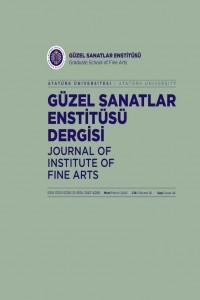ALABANDA: TARİHİ COĞRAFYA, TOPOĞRAFYA, ARAŞTIRMA ve KAZILAR
ÖzBugün Aydın İli, Çine İlçesi’nin yaklaşık olarak 7 km batısında yer alan antik yerleşim, Marsyas (Çine) Çayı’nın batısına konumlanmıştır ve iç Karia’nın en önemli kentlerinden biridir. Kentin kuruluş efsanesinde, Karia dilinde “Ala”nın ‘at’, “Banda”nın ‘zafer’ anlamına geldiği belirtilir. En erken yerleşime ilişkin Hitit metinlerinde adı Waliwanda olarak geçen Alabanda’daki ilk kazı çalışmaları, 1904 -1905 yıllarında Halil Edhem Bey tarafından gerçekleştirilmiştir. Ardından Aydın Müzesi adına Emin YENER ve Doç. Dr. Suat ATEŞLİER tarafından sürdürülmüştür. 2015 yılından itibaren de Doç. Dr. Ali Yalçın TAVUKÇU başkanlığındaki bir ekip Alabanda’nın tarihine ışık tutmaya devam etmektedir. Antik kentte bu güne kadar sur duvarları, tiyatro, tapınaklar, agora, bouleuterion, hamamlar, stadion, nymphaeum, su kemeri, kiliseler, anıt mezarlar ve nekropol alanlarında çok sayıda lahit mezar tespit edilmiştir.Anahtar Kelimeler: Alabanda, Apollon İsotimos, Zeus Khyrsaoreus, Apollonios Molon, Apollonios MalakosAlabanda: Hıstorıcal Geography, Topography, Survey and ExcavationsAbstractToday, the ancient settlement is located on approximately 7 km western side of Çine district of Aydın Province, and the settlement is situated towards the western side of the stream Marsyas (Çine). It is one of the most important cities in the Central Caria. In the founding myth of the city, "Ala” is said to mean 'horse' and “Banda” is said to mean 'victory' in Carian language. As regards to the earliest settlements, the name of this settlement was Waliwanda in Hittite texts and the first excavations of Alabanda were carried out by Halil Edhem Bey in the years 1904 -1905. Then excavations were carried out by Emin YENER and Assoc. Prof. Suat ATEŞLİER on behalf of Aydın Museum. And since 2015, a team headed by Assoc. Prof. Ali Yalçın TAVUKÇU continues to shed light on the history of Alabanda. To this day, castle walls, theater, temples, agora, bouleuterion, baths, stadium, nymphaeum, aqueducts, churches and mausoleums have been identified in the ancient city and a large number of sarcophagus have been identified in the necropolis of the ancient city.Keywords: Alabanda, Apollon Isotimos, Zeus Khyrsaoreus, Apollonios Molon, Apollonios Malakos
Anahtar Kelimeler:
Alabanda, Apollon İsotimos, Zeus Khyrsaoreus, Apollonios Molon, Apollonios Malakos
Alabanda: Hıstorical Geography, Topography, Survey and Excavations
Today, the ancient settlement is located on approximately 7 km western side of Çine district of Aydın Province, and the settlement is situated towards the western side of the stream Marsyas (Çine). It is one of the most important cities in the Central Caria. In the founding myth of the city, "Ala” is said to mean 'horse' and “Banda” means 'victory' in Carian language. In regard to the earliest settlements, the name of this settlement was Waliwanda in Hittite texts and the first excavations of Alabanda were carried out by Halil Edhem Bey in the years 1904 -1905. Then excavations were carried out by Emin YENER and Assoc. Prof. Suat ATEŞLİER on behalf of Aydın Museum. And since 2015, a team headed by Assoc. Prof. Ali Yalçın TAVUKÇU continues to shed light on the history of Alabanda. To this day, castle walls, theater, temples, agora, bouleuterion, baths, stadium, nymphaeum, aqueducts, churches and mausoleums have been identified in the ancient city and a large number of sarcophagus have been identified in the necropolis of the ancient city.
Keywords:
Alabanda, Apollon Isotimos, Zeus Khyrsaoreus, Apollonios Molon, Apollonios Malakos,
- ISSN: 1300-9206
- Yayın Aralığı: Aylık
- Yayıncı: Atatürk Üniversitesi
Sayıdaki Diğer Makaleler
Mustafa Hami'nin "Sevkü'l-Askeri" Elyazmasında Yer Alan Temalı Resim Örnekleri
Abdurrahman Munif ve Risale Min Verai'l-Hudud Adlı Kısa Öyküsü
Trt Sanatçılarının Müzik Eğitimi Durumlarının İncelenmesi
Cengiz Şengül-yiğit Karabulut -RABİA YILAR
"Beni 20 Yıl Sonra Anlayacaklar" Settar Behlulzade
Mustafa Hami'nin "Sevkü'l-Askeri" Elyazmasında Yer Alan Temalı Resim Örnekleri
Kyzikos’ta Yapılan Kazı Ve Sondajlarla İlgili Bir Değerlendirme
Mehmet Karaosmanoğlu -HALİM KORUCU
Abdurrahman Munif ve Risale Min Verai'l-Hudud Adlı Kısa Öyküsü
